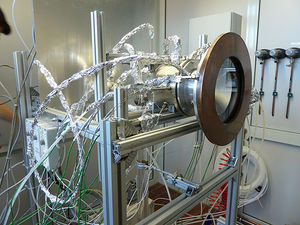Solar Upgrading of Hydrocarbons: Difference between revisions
Jump to navigation
Jump to search
m (→External Links: inserted link) |
mNo edit summary |
||
| Line 1: | Line 1: | ||
[[File:Solar_reactor.jpg|300px|thumb|right|Solar reactor in the lab of Prof. Aldo Steinfeld und doctoral student Philipp Furler at ETHZ (Zurich, Switzerland). This lab has done some work on solar upgrading of hydrocarbons. ]] | [[File:Solar_reactor.jpg|300px|thumb|right|Solar reactor in the lab of Prof. Aldo Steinfeld und doctoral student Philipp Furler at ETHZ (Zurich, Switzerland). This lab has done some work on solar upgrading of hydrocarbons. ]] | ||
Hydrocarbon fuels can be upgraded by various heat sources in endothermic processes. In other words, the calorific value of a liquid (bio-)fuel can be increased by solar thermal input. Gaseous fuels can similarly solar-upgraded via such endothermic processes (e.g. solar reforming or cracking of methane [[biogas]]). One example of this is [[methane to methanol]] | Hydrocarbon fuels can be upgraded by various heat sources in endothermic processes. In other words, the calorific value of a liquid (bio-)fuel can be increased by solar thermal input. Gaseous fuels can similarly solar-upgraded via such endothermic processes (e.g. solar reforming or cracking of methane [[biogas]]). One example of this is the conversion of [[methane to methanol]] using concentrated sunlight. Source of methane can be [[biogas]] or [http://openfarmtech.org/wiki/Compressed_Fuel_Gas syngas]. Methanol is a fuel that is liquid at room temperature and can be used in an internal combustion engine. It is increasingly popular in China to power vehicles. | ||
===Related pages on OSE Wiki=== | ===Related pages on OSE Wiki=== | ||
Revision as of 01:53, 28 January 2011
Hydrocarbon fuels can be upgraded by various heat sources in endothermic processes. In other words, the calorific value of a liquid (bio-)fuel can be increased by solar thermal input. Gaseous fuels can similarly solar-upgraded via such endothermic processes (e.g. solar reforming or cracking of methane biogas). One example of this is the conversion of methane to methanol using concentrated sunlight. Source of methane can be biogas or syngas. Methanol is a fuel that is liquid at room temperature and can be used in an internal combustion engine. It is increasingly popular in China to power vehicles.
Related pages on OSE Wiki
External Links
- Wikipedia: Fossil Fuel Reforming
- Report from SolarPaces (comprehensive): Solar Fuels from Concentrated Sunlight
- Solar Technology Laboratory, Paul Scherrer Institute (PSI)
